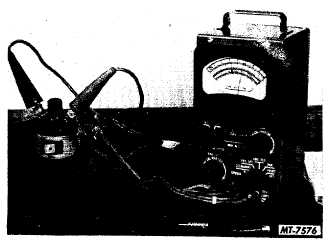|
| |
TRUCK SERVICE MANUAL
TM 5-4210-230-14&P-1
ELECTRICAL
The coil used with the transistor ignition system has the
outward appearance of a standard coil; however, it contains
special high ratio windings that produce higher secondary
voltage at all engine speeds.
COIL SERVICE
Ignition coils do not normally require any service except
to keep all terminals and connections clean and tight. In
addition, the coil should be kept reasonably clean, but it must
not be subjected to steam cleaning or similar cleaning
methods which may cause moisture to enter the coil unless it
is of the hermetically sealed type. Rubber nipples on the high
voltage terminals are valuable in preventing "tracing" or
leakage of current across exposed surfaces.
If poor ignition performance is obtained, and the coil is
suspected of being the cause, the coil may be tested on the
truck or it may be removed for the test.
COIL TESTS
Various types of testing instruments are used in testing
ignition coils. One of these makes use of an open or
protected spark gap, while another reports the coil condition
on a meter or scope. This second type of tester is usually so
designed as to permit testing of the coil without making any
connection to the secondary terminal. This eliminates certain
variables caused by altitude, atmosphere or spark gap
electrode conditions.
The
spark
gap
tester
should
always
be
used
comparatively. That is, a coil known to be good should be
compared with the questionable coil. Both coils should be at
same temperature and identical test leads must be used.
Fig. 3 Coil Tester
Before the testing instrument is used, a lamp and test
point should be applied to check coil for open or grounded
circuits. To test for an open primary circuit, put test points on
the two primary terminals. If lamp does not light, primary
circuit is open. To check secondary circuit, put one test point
in high tension terminal and the other at one of the primary
terminals. Lamp will not light, but tiny sparks will be noted
as test points are rubbed over terminals if secondary winding
is not open. If secondary is open, no sparks will occur.
Most ignition coils can be tested for grounded windings
by placing one test point on a clean part of the metal
container and touching the other point to primary and high
tension terminals. If lamp lights or tiny sparks appear at the
points of contact, windings are grounded.
NOTE: This test does not apply to secondary windings
of coils used on insulated or two: wire electrical systems,
since these coils have one end of the secondary winding
grounded to metal container. The primary winding of this type
of coil, however, may be checked for ground.
When using a meter-type coil tester to test a coil
without removing it from the vehicle, be very careful to avoid
touching tester case to truck. Many such testers have a
ground connection to the case, touching case to truck would
produce a short circuit and possible serious damage to the
equipment.
Details of the testing procedures and the manner in
which various testers are used will be found in the tester
operating instructions.
TWELVE-VOLT SYSTEM
The coil used with the 12-volt system, Fig. 4, has more
turns of wire in both the primary and secondary windings and
a higher ratio between windings than in 6-volt coils of same
size. The increased number of turns in primary winding
results in a higher inductance in this winding, which makes it
possible for coil to provide a higher secondary voltage output
throughout the speed range.
In order to improve ignition performance during
cranking, an ignition resistor is used with the 12-volt ignition
coil. This external resistor is connected in series with primary
circuit between battery and coil.
Ignition resistor is wound with wire which changes
resistance only slightly with temperature. This characteristic
prevents excessive primary current at low temperatures, and
thus reduces the tendency for distributor contact points to
oxidize during cold weather. To
CTS-2013-E Page 4
PRINTED IN UNITED STATES OF AMERICA
|

